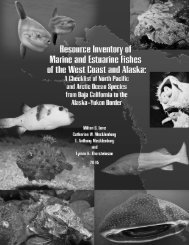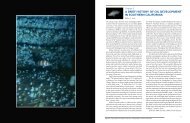Reproductive Ecology and Body Burden of Resident ... - The Love Lab
Reproductive Ecology and Body Burden of Resident ... - The Love Lab
Reproductive Ecology and Body Burden of Resident ... - The Love Lab
You also want an ePaper? Increase the reach of your titles
YUMPU automatically turns print PDFs into web optimized ePapers that Google loves.
tometry. <strong>The</strong> determination <strong>of</strong> selenium in dry-ashed samples was accomplished by flow injection hydride<br />
generation atomic absorption spectroscopy. In this procedure, the digestate was mixed with a hydrochloric<br />
acid carrier solution <strong>and</strong> then reduced by sodium tetrahydridoborate which had been stabilized with sodium<br />
hydroxide. <strong>The</strong> resulting volatile hydrogen selenide was transferred with argon carrier gas into a heated<br />
quartz cell mounted on an atomic absorption spectrophotometer for decomposition <strong>and</strong> measurement.<br />
Of the 63 elements analyzed, a total <strong>of</strong> 21 were deemed suitable for statistical comparisons (Table 4).<br />
<strong>The</strong>se included aluminum, arsenic, barium, cadmium, chromium, cobalt, copper, gallium, iron, lead, lithium,<br />
manganese, mercury, nickel, rubidium, selenium, strontium, tin, titanium, vanadium, <strong>and</strong> zinc. <strong>The</strong>se<br />
21 “quantitative” elements were compared between fishes living around oil platforms <strong>and</strong> natural areas.<br />
Results from mixed models ANCOVA or ANOVA indicated that none <strong>of</strong> the 21 quantitative elements<br />
consistently exhibited higher concentrations in fishes from oil platforms or from natural areas. Out <strong>of</strong> 63<br />
possible comparisons (21 elements measured in three fish species), 44 did not reveal significant differences<br />
between the habitat types, whereas 11 comparisons indicated that elemental concentrations were significantly<br />
higher at natural areas than at oil platforms. <strong>The</strong> remaining 8 comparisons exhibited significant habitat<br />
type-total length interactions, indicating that relative differences in elemental concentrations between<br />
habitat types varied with the length <strong>of</strong> the fish species.<br />
Task 2: Otolith Elemental Signatures <strong>of</strong> Kelp Rockfish (Sebastes atrovirens) <strong>and</strong> Pacific<br />
S<strong>and</strong>dab (Citharichthys sordidus) from Offshore Oil Platforms <strong>and</strong> Natural Areas in the<br />
Southern California Bight<br />
In this study, we sampled 98 kelp rockfish <strong>and</strong> 108 Pacific s<strong>and</strong>dab collected from six <strong>of</strong>fshore oil<br />
platforms <strong>and</strong> 12 natural areas during 2005 <strong>and</strong> 2006 for microchemical analysis <strong>of</strong> 19 elements in otoliths.<br />
<strong>The</strong> majority <strong>of</strong> specimens included in this study were used in the whole-body analysis <strong>of</strong> elements (Task<br />
1). Kelp rockfish were collected by spear using SCUBA at four platforms at midwater depths <strong>and</strong> at six kelp<br />
forest habitat sites. Pacific s<strong>and</strong>dab were collected by hook <strong>and</strong> line at six platforms, including the platforms<br />
where kelp rockfish were collected, <strong>and</strong> six natural habitat sites. At each collection site, fish were bagged together<br />
in a plastic bag <strong>and</strong> kept on ice for up to ten hours. <strong>The</strong> fish were either processed in the laboratory<br />
on the collection day or the whole body samples were frozen until they were thawed <strong>and</strong> processed up to<br />
several weeks later.<br />
Sagittal otoliths were extracted from 8-10 fish specimens per site, rinsed in DI water, <strong>and</strong> stored dry in<br />
a clean plastic snap cap vial until the time <strong>of</strong> preparation for otolith microchemistry. <strong>The</strong> otoliths were measured<br />
along the axis <strong>of</strong> the sulcus to the nearest 0.05 mm <strong>and</strong> weighed to the nearest 0.001 mg. We measured<br />
whole fish total length <strong>and</strong> st<strong>and</strong>ard length <strong>and</strong> weighed whole specimens. Preparation <strong>of</strong> the otoliths for<br />
microchemical analysis included sectioning, polishing, <strong>and</strong> decontamination procedures.<br />
We used laser-ablation inductively coupled plasma mass spectrometry (LA ICP-MS) to sample a discrete<br />
portion <strong>of</strong> the sectioned otolith nearest the edge. Otolith material was vaporized by a 213 nm solid<br />
state Nd:YAg laser ablation system (New Wave UP213), <strong>and</strong> the sample was analyzed on a Finnigan MAT<br />
Element 2-sector field ICP-MS. An imaging system was used to focus the laser on the surface <strong>of</strong> the otolith<br />
<strong>and</strong> to delineate a sample line target, 100 um long x 40 um wide, following the contour <strong>of</strong> the edge <strong>of</strong> the<br />
sectioned otolith. This method <strong>of</strong> sampling the outermost otolith material corresponding to recent growth<br />
before capture reduces the uncertainty that the trace elements were incorporated into the otolith when the<br />
individual did not occupied the locality were it was collected.<br />
<strong>The</strong> isotopes assayed from otolith samples were Aluminum-27 ( 27 Al), Magnesium-24 ( 24 Mg), Calcium-48<br />
( 48 Ca), Vanadium-51 ( 51 V), Chromium-52 ( 52 Cr), Manganese-55 ( 55 Mn), Iron-56 ( 56 Fe), Cobalt-59<br />
( 59 Co), Copper-63 ( 63 Cu), Zinc-66 ( 66 Zn), Strontium-87 ( 87 Sr), Silver-109 ( 109 Ag), Cadmium-114 ( 114 Cd),<br />
Cesium-133 ( 133 Cs), Barium-138 ( 138 Ba), Cerium-140 ( 140 Ce), Mercury-202 ( 202 Hg), Lead-208 ( 208 Pb), <strong>and</strong><br />
vii




